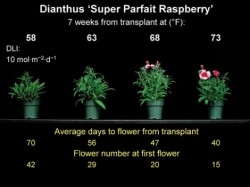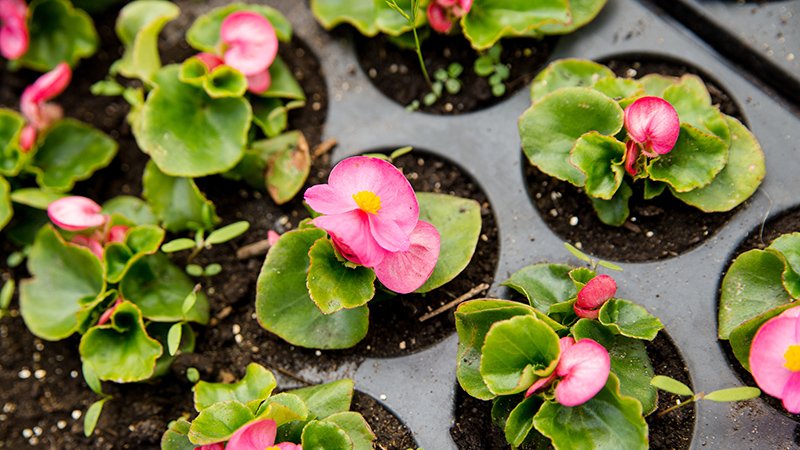Energy-Efficient Annuals: Dianthus & Snapdragon

Energy-efficient greenhouse production requires information on how crops respond to average daily temperature and daily light integral (DLI) so they can be more precisely scheduled. At Michigan State University (MSU), we have performed experiments with many seed-propagated annuals to quantify the effects of temperature and DLI on flowering and the impacts of different cropping strategies on energy consumption. In this article, we present information on dianthus and snapdragon, and then use crop timing data to estimate greenhouse heating costs at different locations, temperatures and finish dates.
Materials and Methods
Seeds of dianthus (Dianthus chinensis ‘Super Parfait Raspberry’) and snapdragon (Antirrhinum majus ‘Montego Burgundy Bicolor’) were sown in 288-cell plug trays by C. Raker & Sons (Litchfield, Mich.). Plugs were then grown in controlled environmental growth chambers at MSU at 68°F (20°C). The photoperiod was 16 hours and the DLI was 10 to 11 mol∙m¯²âˆ™d¯¹.
When plugs were considered marketable (38 days after seed sow for dianthus and 27 days for snapdragon), they were transplanted into 4-inch pots and grown in greenhouses with constant temperature set points of 57, 63, 68, and 73°F (14, 17, 20 and 23°C). At each temperature, plants were grown under a 16-hour photoperiod with two different DLIs provided by a combination of shade curtains and different light intensities from high-pressure sodium lamps. Many varieties of dianthus and snapdragon do not require long days for flowering, but varieties flower faster when long days are provided. Therefore, both crops can be considered facultative long-day plants.
The flowering date was recorded for each plant when dianthus had an inflorescence with the ray petals fully reflexed and snapdragon had an inflorescence with two opened flowers. When each plant flowered, plant height, number of leaves on the flowering shoot, branch number, and number of flowers and flower buds were recorded. The experiment was performed twice to obtain average DLIs that ranged from 4 to 19 mol∙m¯²âˆ™d¯¹.
To give perspective, growers in the North may receive 4 mol∙m¯²âˆ™d¯¹ of light during the winter on a cloudy day, and 19 mol∙m¯²âˆ™d¯¹ of light on a sunny day in early spring. To identify how much light you receive on a typical day outdoors, view the DLI maps created by Jim Faust online at http://hrt.msu.edu/floraoe/productioninfo.htm. Then, take those values and multiply them by the light transmission percentage of your greenhouse (a typical value is 50 to 60 percent).
Crop timing data was used to develop mathematical models to predict flowering time and plant quality under different temperature and DLI conditions. The scheduling models were validated by growing dianthus and snapdragon at three different constant temperatures to compare predicted flowering times with actual times. The Virtual Grower software (available free at www.virtualgrower.net) was used to estimate the cost to heat a 21,504-square-foot greenhouse (about half an acre) to produce each crop for different finish dates and at different locations in the United States.
Results
In both dianthus and snapdragon, time to flower decreased as average daily temperature and DLI increased. For example, under an average DLI of 10 mol∙m¯²âˆ™d¯¹, time to flower of dianthus decreased from 70 to 40 days as temperature increased from 58 to 73°F (Figure 1).
Under the same conditions, time to flower of snapdragon decreased from 40 to 25 days (Figure 2). As DLI increased from 4 to 18 mol∙m¯²âˆ™d¯¹, time to flower in dianthus and snapdragon grown at 63°F decreased by 10 and 17 days, respectively. We can use this crop timing data to determine the date that 288-cell plugs need to be transplanted for two different market dates when grown at different temperatures (Table 1).
The number of flower buds at first flowering increased as temperature decreased and as DLI increased. For example, dianthus grown under 10 mol∙m¯²âˆ™d¯¹ and at 58°F had 27 more flower buds than plants grown under the same DLI, but at 73°F (Figure 1). Snapdragon grown under the same DLI had almost twice the number of flower buds at 58°F compared with plants grown at 68 or 73°F (Figure 2).
Plants grown at 73°F and under 4 mol∙m¯²âˆ™d¯¹ had the fewest flowers and were the poorest quality. Therefore, if these crops are grown at a warm temperature, the DLI should be greater than 4 mol∙m¯²âˆ™d¯¹ to improve plant quality. The number of lateral branches also increased as temperature decreased from 73 to 58°F. Therefore, as with many floriculture crops, there is a trade-off with quick crop timing and high plant quality, especially when the DLI is low.
Heating Costs
The production temperature that had the lowest estimated heating costs to produce a flowering crop of dianthus and snapdragon varied among locations and market dates. For example, to produce a finish crop of dianthus for April 1, a greenhouse located in Grand Rapids, Mich., New York, N.Y., or Cleveland, Ohio, would save 11 to 20 percent on heat per square foot if the crop was transplanted on February 20 and grown at 73°F, compared to the same crop transplanted earlier and grown at 58°F (Table 2).
In other words, a shorter crop time at a warm temperature required less heat on a per-crop basis than a longer crop time at a cool temperature. However, for a greenhouse located in San Francisco, Calif., Tallahassee, Fla., or Fort Worth, Texas, heating costs would increase 17 to 56 percent if dianthus were grown for April 1 at 73°F instead of 58°F.
For market dates later in the spring, outside temperatures are warmer and the greenhouse heating demand is less. Therefore, the most energy-efficient growing temperature can be different depending on the crop and finish date. For example, dianthus grown for April 1 in a greenhouse located in New York, N.Y., would save 2 cents on heating costs per crop per square foot at 73°F versus 63°F, whereas the same crop grown for May 15 would require 1 cent more heat per square foot at 73°F versus 63°F. For snapdragon, a growing temperature of 58 or 63°F consumed the least heat per crop at all locations and for both market dates.
The cost of energy for heating is just one of the many production expenses for greenhouse crops. Other factors, such as the number of crop turns and overhead costs, should also be considered when choosing the most economical growing temperature for each floriculture crop producer.
0
1
5
Energy-Efficient Annuals: Dianthus & Snapdragon










